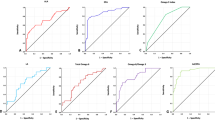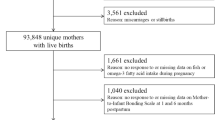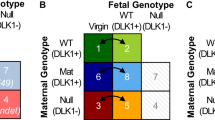Abstract
Background:
Omega 3 (n-3) and 6 (n-6) long-chain polyunsaturated fatty acids (LC-PUFAs) and the n-3:n-6 ratio are important for brain development. Whether maternal LC-PUFA status during pregnancy affects risk of problem behavior in later childhood is unclear.
Methods:
Within a population-based cohort, we measured maternal plasma docosahexaenoic acid (DHA), eicosapentaenoic acid (EPA), and arachidonic acid (AA) concentrations and n-3:n-6-ratio in mid-pregnancy. Child emotional and behavioral problems at 6 y of age were assessed by parents (child behavior checklist), teachers (teacher report form), and combined parent/teacher report.
Results:
Higher maternal DHA and n-3:n-6 ratio were associated with fewer child emotional problems using parent (odds ratio (OR)DHA = 0.82; 95% confidence interval (CI): 0.70, 0.96; P = 0.02 and ORn-3:n-6 = 0.83; 95% CI: 0.71, 0.96; P = 0.01; n = 5,307) and combined parent/teacher scores (ORDHA = 0.79; 95% CI: 0.66, 0.95; P = 0.01 and ORn-3:n-6 = 0.77; 95% CI: 0.65, 0.92; P < 0.01; n = 2,828). Higher AA was associated with more child behavioral problems using teacher (OR = 1.10; 95% CI: 1.00, 1.20; P = 0.04; n = 3,365) and combined parent/teacher scores (OR = 1.12; 95% CI: 1.02, 1.22; P = 0.02; n = 2,827). Maternal EPA was not associated with child problem behavior.
Conclusion:
Indications of associations of maternal LC-PUFA status with child emotional and behavioral problems were found. Future research is needed to identify LC-PUFA–sensitive periods of fetal brain development by including multiple assessments of prenatal LC-PUFA status.
Similar content being viewed by others
Log in or create a free account to read this content
Gain free access to this article, as well as selected content from this journal and more on nature.com
or
References
Lauritzen L, Hansen HS, Jørgensen MH, Michaelsen KF . The essentiality of long chain n-3 fatty acids in relation to development and function of the brain and retina. Prog Lipid Res 2001;40:1–94.
Yehuda S . Omega-6/omega-3 ratio and brain-related functions. In: Simopoulos AP, Cleland LG, eds. Omega-6/Omega-3 Essential Fatty Acid Ratio: The Scientific Evidence. World Rev Nutr Diet. Basel: Karger, 2003:37–56.
Uauy R, Mena P, Rojas C . Essential fatty acids in early life: structural and functional role. Proc Nutr Soc 2000;59:3–15.
Gil-Sánchez A, Demmelmair H, Parrilla JJ, Koletzko B, Larqué E . Mechanisms involved in the selective transfer of long chain polyunsaturated Fatty acids to the fetus. Front Genet 2011;2:57.
Hibbeln JR, Davis JM, Steer C, et al. Maternal seafood consumption in pregnancy and neurodevelopmental outcomes in childhood (ALSPAC study): an observational cohort study. Lancet 2007;369:578–85.
Gale CR, Robinson SM, Godfrey KM, Law CM, Schlotz W, O’Callaghan FJ . Oily fish intake during pregnancy–association with lower hyperactivity but not with higher full-scale IQ in offspring. J Child Psychol Psychiatry 2008;49:1061–8.
Waylen A, Ford T, Goodman R, Samara M, Wolke D . Can early intake of dietary omega-3 predict childhood externalizing behaviour? Acta Paediatr 2009;98:1805–8.
Chen HF, Su HM . Exposure to a maternal n-3 fatty acid-deficient diet during brain development provokes excessive hypothalamic-pituitary-adrenal axis responses to stress and behavioral indices of depression and anxiety in male rat offspring later in life. J Nutr Biochem 2013;24:70–80.
Dunstan JA, Simmer K, Dixon G, Prescott SL . Cognitive assessment of children at age 2(1/2) years after maternal fish oil supplementation in pregnancy: a randomised controlled trial. Arch Dis Child Fetal Neonatal Ed 2008;93:F45–50.
Krabbendam L, Bakker E, Hornstra G, van Os J . Relationship between DHA status at birth and child problem behaviour at 7 years of age. Prostaglandins Leukot Essent Fatty Acids 2007;76:29–34.
Kohlboeck G, Glaser C, Tiesler C, et al.; LISAplus Study Group. Effect of fatty acid status in cord blood serum on children’s behavioral difficulties at 10 y of age: results from the LISAplus Study. Am J Clin Nutr 2011;94:1592–9.
Loomans EM, Van den Bergh BR, Schelling M, Vrijkotte TG, van Eijsden M . Maternal long-chain polyunsaturated fatty acid status during early pregnancy and children’s risk of problem behavior at age 5-6 years. J Pediatr 2014;164:762–8.
Rescorla LA, Bochicchio L, Achenbach TM, et al. Parent-teacher agreement on children’s problems in 21 societies. J Clin Child Adolesc Psychol 2014;43:627–42.
Innis SM, de La Presa Owens S . Dietary fatty acid composition in pregnancy alters neurite membrane fatty acids and dopamine in newborn rat brain. J Nutr 2001;131:118–22.
Kodas E, Galineau L, Bodard S, et al. Serotoninergic neurotransmission is affected by n-3 polyunsaturated fatty acids in the rat. J Neurochem 2004;89:695–702.
Romijn HJ, Hofman MA, Gramsbergen A . At what age is the developing cerebral cortex of the rat comparable to that of the full-term newborn human baby? Early Hum Dev 1991;26:61–7.
Al MD, van Houwelingen AC, Kester AD, Hasaart TH, de Jong AE, Hornstra G . Maternal essential fatty acid patterns during normal pregnancy and their relationship to the neonatal essential fatty acid status. Br J Nutr 1995;74:55–68.
Georgieff MK, Innis SM . Controversial nutrients that potentially affect preterm neurodevelopment: essential fatty acids and iron. Pediatr Res 2005;57(5 Pt 2):99R–103R.
Kawakita E, Hashimoto M, Shido O . Docosahexaenoic acid promotes neurogenesis in vitro and in vivo. Neuroscience 2006;139:991–7.
Coti Bertrand P, O’Kusky JR, Innis SM . Maternal dietary (n-3) fatty acid deficiency alters neurogenesis in the embryonic rat brain. J Nutr 2006;136:1570–5.
Olivier JD, Akerud H, Kaihola H, et al. The effects of maternal depression and maternal selective serotonin reuptake inhibitor exposure on offspring. Front Cell Neurosci 2013;7:73.
Assisi A, Banzi R, Buonocore C, et al. Fish oil and mental health: the role of n-3 long-chain polyunsaturated fatty acids in cognitive development and neurological disorders. Int Clin Psychopharmacol 2006;21:319–36.
Jaddoe VW, van Duijn CM, Franco OH, et al. The Generation R Study: design and cohort update 2012. Eur J Epidemiol 2012;27:739–56.
Glaser C, Demmelmair H, Koletzko B . High-throughput analysis of fatty acid composition of plasma glycerophospholipids. J Lipid Res 2010;51:216–21.
Achenbach TM, Rescorla LA . Manual for the ASEBA Preschool Forms & Profiles. Burlington, VT: University of Vermont, Research Center for Children, Youth, and Families, 2000.
Tick NT, van der Ende J, Koot HM, Verhulst FC . 14-year changes in emotional and behavioral problems of very young Dutch children. J Am Acad Child Adolesc Psychiatry 2007;46:1333–40.
Achenbach TM, Rescorla LA . Manual for the ASEBA School-Age Forms & Profiles. Burlington, VT: University of Vermont, Research Center for Children, Youth, and Families, 2001.
Achenbach TM, Rescorla LA . Multicultural Supplement to the Manual for the ASEBA School-Age Forms & Profiles. Burlington, VT: University of Vermont, Research Center for Children, Youth, and Families, 2007.
Lavigne JV, Hopkins J, Gouze KR, et al. Is smoking during pregnancy a risk factor for psychopathology in young children? A methodological caveat and report on preschoolers. J Pediatr Psychol 2011;36:10–24.
Kiefte-de Jong JC, de Vries JH, Bleeker SE, et al. Socio-demographic and lifestyle determinants of ‘Western-like’ and ‘Health conscious’ dietary patterns in toddlers. Br J Nutr 2013;109:137–47.
Willett WC, Howe GR, Kushi LH . Adjustment for total energy intake in epidemiologic studies. Am J Clin Nutr 1997;65:Suppl 4:1220S–8S; discussion 1229S–1231S.
Acknowledgements
The Generation R Study is conducted by the Erasmus Medical Center in close collaboration with the School of Law and the Faculty of Social Sciences at the Erasmus University, Rotterdam; the Municipal Health Service, Rotterdam area; and the Stichting Trombosedienst & Artsenlaboratorium Rijnmond (Star-MDC), Rotterdam. We gratefully acknowledge the contribution of participating mothers, general practitioners, hospitals, midwives, and pharmacies in Rotterdam, The Netherlands.
Author information
Authors and Affiliations
Corresponding author
Supplementary information
Supplementary Table S1
(DOC 62 kb)
PowerPoint slides
Rights and permissions
About this article
Cite this article
Steenweg-de Graaff, J., Tiemeier, H., Basten, M. et al. Maternal LC-PUFA status during pregnancy and child problem behavior: the Generation R Study. Pediatr Res 77, 489–497 (2015). https://doi.org/10.1038/pr.2014.204
Received:
Accepted:
Published:
Issue date:
DOI: https://doi.org/10.1038/pr.2014.204
This article is cited by
-
Feeding practice during infancy is associated with attention-deficit/hyperactivity disorder and autism spectrum disorder: a population-based study in South Korea
European Journal of Pediatrics (2023)
-
Developmental Programming in Animal Models: Critical Evidence of Current Environmental Negative Changes
Reproductive Sciences (2023)
-
Prenatal exposure to trans fatty acids and head growth in fetal life and childhood: triangulating confounder-adjustment and instrumental variable approaches
European Journal of Epidemiology (2022)
-
Placental 13C-DHA metabolism and relationship with maternal BMI, glycemia and birthweight
Molecular Medicine (2021)
-
Polyunsaturated fatty acids in middle childhood and externalizing and internalizing behavior problems in adolescence
European Journal of Clinical Nutrition (2020)



